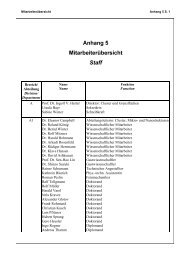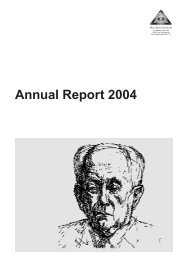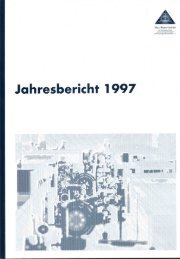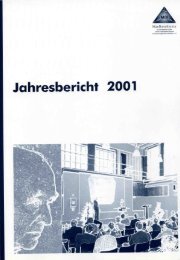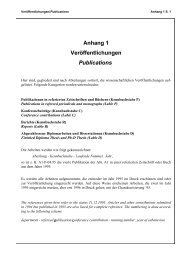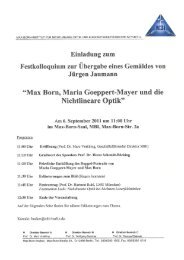You also want an ePaper? Increase the reach of your titles
YUMPU automatically turns print PDFs into web optimized ePapers that Google loves.
Fig. 3<br />
A sketch of an optical interferometer. An optical<br />
beam is split at a beam splitter and the<br />
two parts of the beam follow different optical<br />
paths. In the overlap region the beams interfere.<br />
The interference pattern contains information<br />
that will allow us to reconstruct both<br />
Fig. 4<br />
A time line showing the duration of the shortest optical<br />
pulses that could be produced. You will see that we<br />
have just crossed the attosecond threshold. The period<br />
of the Bohr orbit for valence electrons in atoms and<br />
molecules is ~ 100 attoseconds. Pulses shorter than ~<br />
100 attoseconds allow us to “freeze” electron motion.<br />
A related set of images occupied the front cover of the October 19 th edition of Scientific American<br />
in 1878. If we could make similar images of molecules as they undergo chemical reactions,<br />
then we could “watch” chemical processes as they unfold, just as Muyerbridge’s photos<br />
allowed him to watch the real motion of the horse.<br />
You, the reader, may say that <strong>Max</strong> <strong>Born</strong> would have objected. “Quantum Mechanics” he might say,<br />
“showed that it is impossible to obtain sharp images” and he would be correct. The image that we<br />
obtain is the image of a wave. However, anyone who visits a wave pool and or sits on a beach<br />
watching ocean waves break on the shore, knows that images of waves are also arresting.<br />
One last thing before I begin to discuss how attosecond images can be recorded. <strong>Max</strong> <strong>Born</strong><br />
wrote a very famous textbook on optics that is still used today [3]. He would have told you that<br />
we often use an interferometer to characterize light waves. Figure 3 is a sketch of an optical<br />
interferometer. Light entering from the bottom of the figure encounters a beam splitter (which<br />
is really a mirror that partially transmits light). Some of the light beam passes through the mirror,<br />
and some reflects from it. The part that reflects is directed back and overlaps the part that<br />
passed through. As the light beams intersect, the light waves interfere with each other. By measuring<br />
the interference pattern, we can determine everything about the light waves in each<br />
beam – their spatial pattern, their frequency, etc. It is as if we could see the individual waves<br />
in each light beam. I will now show you how to make an electron interferometer in a single<br />
molecule [4].<br />
When setting out to make an electron interferometer that can image the molecule’s electron,<br />
you will immediately be confronted by three challenges: First, “how can we split the molecule’s<br />
electron?” I will show you that it can be done with an intense laser pulse. Second, “how<br />
can we make the electron return to interfere with itself?” I will also show you that this happens<br />
naturally when an intense laser pulse splits the electron. And finally, “how can we see the<br />
interference if it occurs?” That brings me back to the title of my talk “attosecond imaging.” I<br />
will show you that the attosecond optical pulses or trains of optical pulses are produced by this<br />
interference, and therefore measuring the attosecond pulses is equivalent to measuring the<br />
interference.<br />
The ability to generate attosecond pulses is the culmination of 40 years of development of<br />
short-pulse laser science and technology. Lasers were achieved experimentally in 1960. In my<br />
opinion, the laser was one of the major developments of the second half of the 20 th century.<br />
And just like quantum mechanics before it, laser science built on pre-existing science – in this<br />
case optics and quantum mechanics. Furthermore, just as quantum mechanics transformed the<br />
science that followed, lasers are now transforming experimental science.<br />
Attosecond Pulses<br />
<strong>Max</strong> <strong>Born</strong> • Paul Corkum 35



